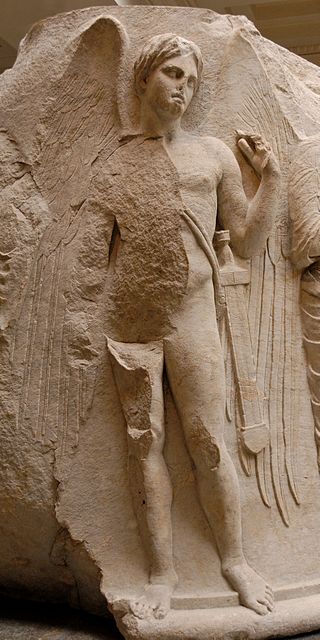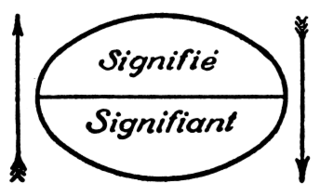Related Research Articles

As a literary device or artistic form, an allegory is a narrative or visual representation in which a character, place, or event can be interpreted to represent a hidden meaning with moral or political significance. Authors have used allegory throughout history in all forms of art to illustrate or convey complex ideas and concepts in ways that are comprehensible or striking to its viewers, readers, or listeners.

Jacques Marie Émile Lacan was a French psychoanalyst and psychiatrist. Described as "the most controversial psycho-analyst since Freud", Lacan gave yearly seminars in Paris, from 1953 to 1981, and published papers that were later collected in the book Écrits. His work made a significant impact on continental philosophy and cultural theory in areas such as post-structuralism, critical theory, feminist theory and film theory, as well as on the practice of psychoanalysis itself.

A metaphor is a figure of speech that, for rhetorical effect, directly refers to one thing by mentioning another. It may provide clarity or identify hidden similarities between two different ideas. Metaphors are often compared with other types of figurative language, such as antithesis, hyperbole, metonymy, and simile. One of the most commonly cited examples of a metaphor in English literature comes from the "All the world's a stage" monologue from As You Like It:
Psychoanalysis is a set of theories and therapeutic techniques that deal in part with the unconscious mind, and which together form a method of treatment for mental disorders. The discipline was established in the early 1890s by Sigmund Freud, whose work stemmed partly from the clinical work of Josef Breuer and others. Freud developed and refined the theory and practice of psychoanalysis until his death in 1939. In an encyclopedia article, he identified the cornerstones of psychoanalysis as "the assumption that there are unconscious mental processes, the recognition of the theory of repression and resistance, the appreciation of the importance of sexuality and of the Oedipus complex." Freud's students Alfred Adler and Carl Gustav Jung developed offshoots of psychoanalysis which they called individual psychology (Adler) and Analytical Psychology (Jung), although Freud himself wrote a number of criticisms of them and emphatically denied that they were forms of psychoanalysis. Psychoanalysis was later developed in different directions by neo-Freudian thinkers, such as Erich Fromm, Karen Horney, and Harry Stack Sullivan.

Sigmund Freud was an Austrian neurologist and the founder of psychoanalysis, a clinical method for evaluating and treating pathologies seen as originating from conflicts in the psyche, through dialogue between patient and psychoanalyst, and the distinctive theory of mind and human agency derived from it.

Dream interpretation is the process of assigning meaning to dreams. Although associated with some forms of psychotherapy, there is no reliable evidence that understanding or interpreting dreams has a positive impact on one's mental health.

Metonymy is a figure of speech in which a concept is referred to by the name of something closely associated with that thing or concept.

A Gorgon is a creature in Greek mythology. Gorgons occur in the earliest examples of Greek literature. While descriptions of Gorgons vary, the term most commonly refers to three sisters who are described as having hair made of living, venomous snakes and horrifying visages that turned those who beheld them to stone. Traditionally, two of the Gorgons, Stheno and Euryale, were immortal, but their sister Medusa was not and was slain by the demigod and hero Perseus.

In Greek mythology, Thanatos was the personification of death. He was a minor figure in Greek mythology, often referred to but rarely appearing in person.

A marionette is a puppet controlled from above using wires or strings depending on regional variations. A marionette's puppeteer is called a marionettist. Marionettes are operated with the puppeteer hidden or revealed to an audience by using a vertical or horizontal control bar in different forms of theatres or entertainment venues. They have also been used in films and on television. The attachment of the strings varies according to its character or purpose.

In human anatomy, the metacarpal bones or metacarpus form the intermediate part of the skeletal hand located between the phalanges of the fingers and the carpal bones of the wrist, which forms the connection to the forearm. The metacarpal bones are analogous to the metatarsal bones in the foot.
In psychology, displacement is an unconscious defence mechanism whereby the mind substitutes either a new aim or a new object for goals felt in their original form to be dangerous or unacceptable.
Semantic change is a form of language change regarding the evolution of word usage—usually to the point that the modern meaning is radically different from the original usage. In diachronic linguistics, semantic change is a change in one of the meanings of a word. Every word has a variety of senses and connotations, which can be added, removed, or altered over time, often to the extent that cognates across space and time have very different meanings. The study of semantic change can be seen as part of etymology, onomasiology, semasiology, and semantics.
In continental philosophy, the Real refers to the remainder of reality that cannot be expressed, and which surpasses reasoning. In Lacanianism, it is an "impossible" category because of its opposition to expression and inconceivability.
[T]he real in itself is meaningless: it has no truth for human existence. In Lacan's terms, it is speech that "introduces the dimension of truth into the real."
"The Instance of the Letter in the Unconscious, or Reason Since Freud" is an essay by the psychoanalyst Jacques Lacan, originally delivered as a talk on May 9, 1957 and later published in Lacan's 1966 book Écrits.

The uncanny is the psychological experience of an event or individual as not simply mysterious, but frightening in a way that feels oddly familiar. This phenomenon is used to describe incidents where a familiar thing or event is encountered in an unsettling, eerie, or taboo context.
In Freudian psychology, a condensation is when a single idea or dream object stands for several associations and ideas.
Jean-Gerard Bursztein is a French psychoanalyst who has a doctorate in philosophy. He teaches psychoanalysis and practices in Paris. He was a student of Jean-Toussaint Desanti and worked on both philosophy of mathematics and philosophy of science. He continues to explore this field in studying the intrication of psychoanalysis and mathematics. On the basis of his practice he has written the following publications :

In semiotics, signified and signifier stand for the two main components of a sign, where signified pertains to the "plane of content", while signifier is the "plane of expression". The idea was first proposed in the work of Swiss linguist Ferdinand de Saussure, one of the two founders of semiotics.

The Dream – Introduction into the Psychology of Dreams is a book by the Austrian psychoanalyst Herbert Silberer, written 1918 in Vienna and published 1919 by Ferdinand Enke in Stuttgart. His main intention was to provide a short, comprehensible guide on how to read and understand more sophisticated literature on dreams, as well as giving an appreciation of fundamental dream phenomena, because he considered both of them as lacking at this time. Silberer himself called this book the preamble for more sophisticated and complicated works, which could then build up on his own work.
References
- 1 2 Roman Jakobson and Halle, Morris (1956) Two Aspects of Language and Two Types of Aphasic Disturbances in Fundamentals of Language. The Hague & Paris: Mouton, section The Metaphoric and Metonymic Poles
- 1 2 Grigg, Russell (2009) Lacan, language, and philosophy , chapter 11 Lacan and Jakobson - Metaphor and Metonymy pp. 151–2, 160
- 1 2 Dirven, René (2003). "Metonymy and Metaphor: Different Mental Strategies of Conceptualisation". In Dirven, René; Pörings, Ralf (eds.). Metaphor and Metonymy in Comparison and Contrast (revised ed.). de Gruyter. pp. 75–112. ISBN 9783110173741 . Retrieved 14 May 2016.
- ↑ Jakobson, Roman (1956). "The Metaphoric and Metonymic Poles". In Dirven, René; Pörings, Ralf (eds.). Metaphor and Metonymy in Comparison and Contrast (revised ed.). de Gruyter. pp. 41–48. ISBN 9783110173741 . Retrieved 14 May 2016.
- ↑ μεταφορά, Henry George Liddell, Robert Scott, A Greek-English Lexicon, on Perseus
- ↑ cdasc3D%2367010 μεταφέρω, Henry George Liddell, Robert Scott, A Greek-English Lexicon, on Perseus
- ↑ μετά, Henry George Liddell, Robert Scott, A Greek-English Lexicon, on Perseus
- ↑ φέρω, Henry George Liddell, Robert Scott, A Greek-English Lexicon, on Perseus
- ↑ Welsh, Alfred Hux; James Mickleborough Greenwood (1893). Studies in English Grammar: A Comprehensive Course for Grammar Schools, High Schools, and Academies. New York City: Silver Burdett. p. 222.
- ↑ BlackwellReference.com
- ↑ Leopold Szondi (1956) Ich-Analyse, subtitled Die Grundlage zur Vereinigung der Tiefenpsychologie. Huber, Bern und Stuttgart, 1956, Kapitel I Das Unbewußte im Lichte der Psychoanalyse S. Freuds, V. Die Phänomenologie des Unbeweßten nach S.Freud p.50 quotation:
Ad.2 Die Beweglichkeit der Besetzungsintensitäten.
Im System Unbewußt kann eine Vorstellung ihren ganzen Besetzungsbetrag, d. h. die ganze Libidomenge, an eine andere Vorstellung abgeben. Freud nennt diesen Vorgang «Verschiebung».
Im Ubw ist es ferner möglich, daß eine einzige Vorstellung die ganze Libido-besetzung mehrerer anderer Vorstellungen an sich nimmt. Freud spricht in diesem Fall von «Verdichtung».
Die beiden Vorgänge - Verschiebung und Verdichtung - tragen den Sammelnamen: psychischer Primärvorgang. Dieser ist für das Ubw charakteristisch und steht im Gegensatz zu dem Sekundärvorgang, der sich im Vorbewußt abspielt.
Die Verschiebung und die Verdichtung sind die führenden Vorgänge im Unbewußten im besonderen bei der Traumarbeit. Sie sind eben primäre Prozesse des Ubw. Träume erhalten aber häufig eine nachträgliche Fassade dadurch, daß die Traumbestandteile nachträglich zu einer «Traumkomposition» zusammengefügt werden. FREUD hegt die Meinung, daß diese Fassade, diese Traumkomposition, sekundärer Natur sei, indem diese sekundäre Zusammenfassung «auf den bereits vorgebildeten Trauminhalt erst nachträglich einwirke»(1). Diese sekundäre Bearbeitung der primären Trauminhalte soll sich im Vbw abspielen. Die primären Vorgänge in Ubw werden eben durch den Charakter der Verschiebung und Verdichtung agnosziert. - ↑ Lacan [1957] The Agency of the Letter in the Unconscious or Reason Since Freud. French original available here.